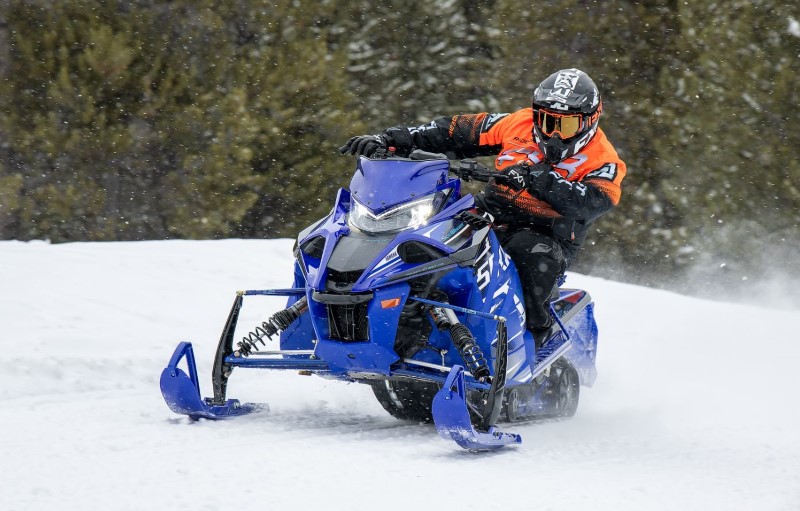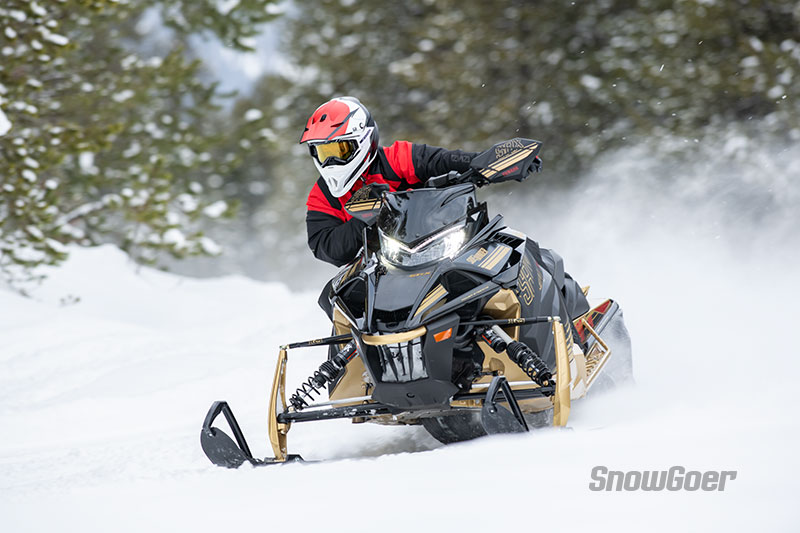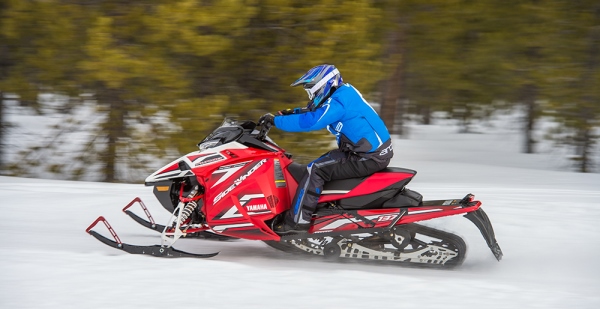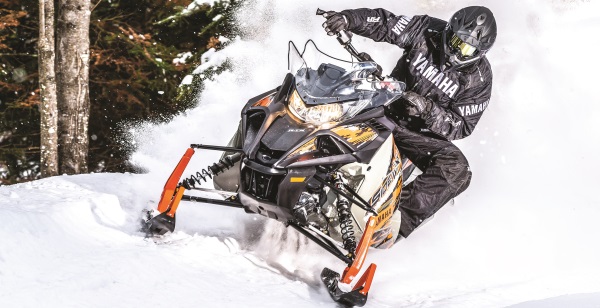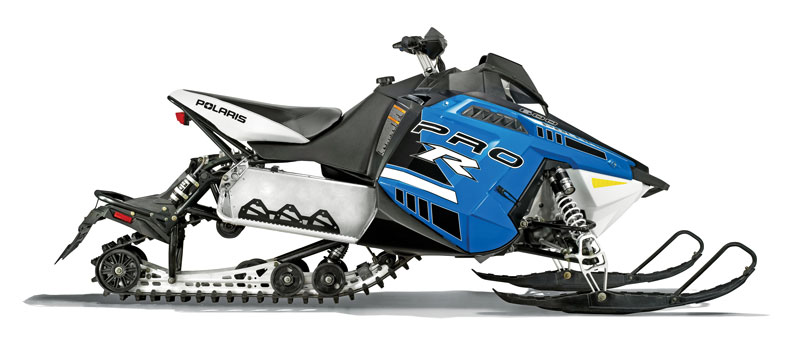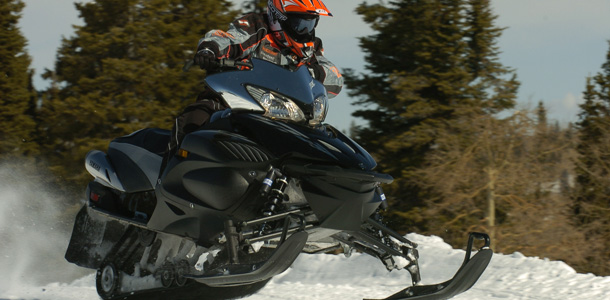 If you drive an automobile built since the 1970s, you’ve grown very accustomed to power steering in that application – in fact, most people can hardly even remember a time when they had to muscle around a car without power steering. And, if you’re paying attention to the ATV market at all, you know that models equipped with electronic power steering (EPS) are now the best-sellers in that market.
If you drive an automobile built since the 1970s, you’ve grown very accustomed to power steering in that application – in fact, most people can hardly even remember a time when they had to muscle around a car without power steering. And, if you’re paying attention to the ATV market at all, you know that models equipped with electronic power steering (EPS) are now the best-sellers in that market.
But what about power steering on a sled? Following the impact of EPS on the four-wheeler market, we knew its day would come, and the day is today, thanks to Yamaha’s Apex line of snowmobiles.
Yamaha’s system provides lighter steering and reduces the harsh feedback that normally comes through the handlebars. Also, the amount of assistance the power steering motor provides is variable – so the driver gets maximum assistance when traveling at low speeds, and the level of assistance drops as speeds increase to maintain control.
The addition of power steering also allowed Yamaha engineers to make other changes to their sleds, as the company can get more aggressive up front because worries about the driver suffering from heavy steering are eliminated.
So how does it all work? And what impact will power steering have on the snowmobile market?
Looking At The Parts
The power steering assembly found on the Apex models comes directly from Yamaha’s Grizzly line of ATVs. The company hasn’t released any official weights, but we know in an ATV application the power steering motor and related assembly weighs about 15 pounds.
The Apex EPS assembly sits just below the handlebars, in front of the fuel tank, and behind the engine. An upper steering shaft comes out of the top of it and connects to the handlebars; a lower steering shaft comes out of the bottom and leads to the linkage that connects to the skis.
“The old steering shaft has basically been split in half,” explained Jim Vizanko, assistant testing manager at Yamaha. The actual power steering motor mounts perpendicular to the split shaft, with a driven worm gear working on the steering shafts to provide the needed assistance. The power steering motor turns a gear to act against the steering shaft to reduce the force needed when turning the snowmobile.
The system is tied into the snowmobile’s electronic control module (ECM), which tells the power steering motor what to do. The ECM makes its decisions based on feedback from two different inputs – the snowmobile’s track speed and the steering shaft torque.
The twisting force of torque is measured in Newton meters (Nm), and at its peak, the Yamaha power steering motor can provide up to 22.9Nm of assistance to the steering shafts – which converts to just under 17 pound-feet. That’s input the driver doesn’t have to put in with his or her arms and shoulders.

How It Works
If you’re going down a long, straight snowmobile trail on a 2011 Apex with the handlebars straight, the power steering system isn’t doing anything – whether you’re going 20 mph or 100 mph, it’s merely along for the ride. But then the trail turns right – what’s happening with the power steering?
When the driver starts turning the bars, the sensors instantaneously recognize the torque input on the steering system, the ECM runs that information in a quick equation against the track speed, and it tells the power steering system to help turn the handlebars in the intended direction. At low speeds, it’s most often helping a lot – up to the 22.9Nm if under 35 mph. At higher speeds, it’s helping less, on a mapped scale.
When thinking about how the EPS system works, however, don’t allow yourself to only think about the speed input. The system doesn’t provide full torque in every situation under 35 mph: if the driver encounters a 90 degree corner and cranks the bars, it provides more help than if the driver encounters a wide, bending corner and only puts limited input into the handlebars.
The scaling of the torque vs. the speed is the magic in calibrating the system. In engineering speak, the map that determines the amount of assistance that is put into the steering system is described by Vizanko as “logic.”
“It is very important [that] the logic of the EPS system matches the logic under the helmet,” Vizanko explained. “The snowmobile consumer is exposed to EPS when they get in the car each morning and go to work, but that logic was developed for tire and steering wheels on smooth roads.
“Snowmobiles run on all types of snow from early season powder to the hard snow of late season,” Vizanko said. “If you think of the forces on a ski, they are generated by side pressure on the keel. Going down the trail or letting it loose across a frozen lake, you don’t crank the handlebars to make the vehicle turn or you will end up on your head. Minor adjustments are all you need to control the sled, as you know.”
A side benefit of the power steering system is that it not only helps turn the bars when the driver puts in inputs, it also dampens some of the harsh feedback that can come up through the handlebars. In a choppy corner, for instance, the forces that sometimes feel like they want to tear the handlebars out of your hands are absorbed by the power steering system. In the ATV market, most observers actually consider that anti-kickback effect as a more significant benefit than lighter steering.
EPS Allows Other Changes
In front suspension design and calibration, engineers are always trying to find a balance between sharp handling and, among other factors, heavy steering. An aggressive ski and geometry design might make the sled bite really hard in corners – but that bite is often too hard for many drivers, who will complain about the heavy steering and darting.
With the addition of power steering, however, Yamaha was able to take the heaviness of the steering out of the equation. With the 2011 Apex, Yamaha went with more aggressive skis featuring a deeper keel that starts farther back on the ski. Also, the engineers changed where the spindle mounts to the ski – adding more “trail,” which helps reduce ski lift while adding precision in corners.
In our testing, the Apex definitely handled better and cornered flatter than previous Apex models, though the more aggressive setup did add some darting where we were testing on in March. That said, we didn’t physically fight that darting as much as we would have on a non-EPS sled.
The EPS system definitely makes the Apex a better snowmobile – it steers lighter and handles better than last year’s model, for sure. Yet it still feels like an Apex, with many of the same attributes and detriments of previous models.
Seeing what has happened in the ATV market in the last three years, and noting that every current snowmobile manufacturer builds power steering-equipped ATVs, it’s almost impossible to envision a future without power steering on high-end snowmobiles. However, such technology comes at a price – the base 2011 Apex has a retail price of $13,999 – a $2,600 jump from 2010, though admittedly there’s other technology and upgrades that add to the cost. Still, that’s a lot of clams for a snowmobile.
A more fair comparison may again come from the ATV market, where manufacturers charge anywhere between $400 to $1,200 for a power steering upgrade on an existing model. Yamaha charges $600 extra for a Grizzly 700 with EPS vs. a base Grizzly – and the EPS model far outsells the base model, proving that consumers value the benefits power steering provides.
— John T. Prusak

